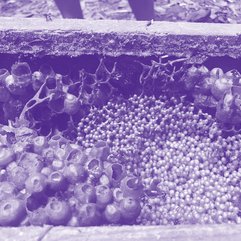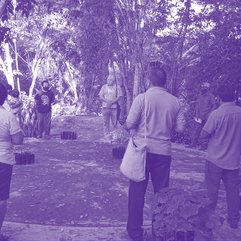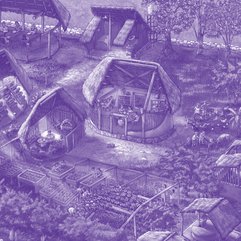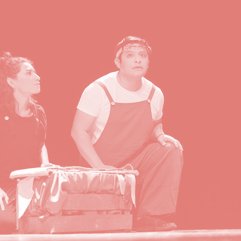Harvest Moon Transitions II
A performance weekend to celebrate newly commissioned works in the exhibitions
10.00-20.00
Save the Date
all ages welcome
in German/in English

In the second transition of this year, Harvest Moon unveils newly commissioned works that keep transforming the exhibitions with lived cultural experiences, voices, and knowledges hailing from the many communities we engage with.
For the growing exhibition XOOK K’IIN perceiving temporalities, Edgar Calel creates two new works that make visible aspects of the language, culture, and cosmovision of his community, the Kaqchikel, Indigenous Peoples of the midwestern highlands of Guatemala. Mayur and Tushar Vayeda present us with a compelling documentary engaging with farmers, shamans, and artists practicing the observation of behavior of farm animals, insects, birds, trees, and wildlife for weather forecasting–an established practice among the Warli communities, Indigenous Peoples in Western India.
In the ever-changing U JUUM BÀALAM KAAB the humming of the guardian bee, artist Bärbel Rothhaar’s two-part installation “Flugfeld*Duftfeld / Flying Field*Scent Field” presents a growing pollen map of Neukölln with a beehive at its center, revealing the seasonal fluctuation of pollen, nectar, propolis, and water supplies in the immediate vicinity of bees. The map features landmarks relevant for and used by bees in navigating a changing urban landscape of buildings, streets, parks, trees, and bodies of water.
Dharmendra Prasad brings rural knowledge systems from his home in Bihar to KUXAÁN SÚUM the living rope with his work “Banihaari Katha (Harvest Stories),” which tells stories of Banihaars (harvesters in Bhjouri) – farm laborers in Bihar who are deprived any claim of the land or crops they cultivate, instead, they receive a share of the bani (bundle of crops) during harvest seasons.
Program
2:00 –6:00 pm A Flying Seed and a Bird Named Hiramon
- performative storytelling sessions with Yasmin Jahan Nupur
3:00 - 5:00 pm Sammel(aus)flug (Pollenwalk), Bärbel Rothhaar and Moabees
- artwork activation by Bärbel Rothhaar and Moabees
4:00 – 5:00 pm Guided tour by Antonia Alampi
5:00 – 6:00 pm Señales en Común (Signals in Common)
- sound production by Ariel Guzik, Emilio Gálvez y Fuentes, and Alejandro Colinas
Finally, the Studio is transformed by a performative conversation with Yasmin Jahan Nupur, accompanying her hand-woven soft sculptures, and engaging her visitors with A Flying Seed and a Bird Named Hiramon, an intimate story-sharing moment, prompting the audience to unwind, connect, and delve in conversations on childhood, memories of forgotten places, rivers, and emotions, community experiences of homeland, migration, and changing ecology. As storytelling played an important role in Yasmin’s childhood, a crucial part of her work is interacting with children and people of all ages to revisit and breathe new life into the folktales that are almost forgotten.
Señales en Común (Signals in Common) is a sound performance by Ariel Guzik, Emilio Gálvez y Fuentes and Alejandro Colinas that compiles field recordings made in marine and terrestrial locations, which include voices and songs of fauna, as well as the sonorities of machines and instruments designed by Ariel Guzik and built at the Nature Expression and Resonance Research Laboratory.
Image by Ariel Guzik








